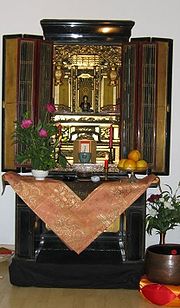
Butsudan
Encyclopedia

Shrine
A shrine is a holy or sacred place, which is dedicated to a specific deity, ancestor, hero, martyr, saint, daemon or similar figure of awe and respect, at which they are venerated or worshipped. Shrines often contain idols, relics, or other such objects associated with the figure being venerated....
commonly found in temples and homes in Japanese Buddhist
Buddhism in Japan
The history of Buddhism in Japan can be roughly divided into three periods, namely the Nara period , the Heian period and the post-Heian period . Each period saw the introduction of new doctrines and upheavals in existing schools...
cultures. A butsudan is a wooden cabinet
Cabinet (furniture)
A cabinet is usually a box-shaped piece of furniture with doors or drawers for storing miscellaneous items. Some cabinets stand alone while others are built into a wall or are attached to it like a medicine cabinet. Cabinets are typically made of wood or, now increasingly, of synthetic...
with doors that enclose and protect a gohonzon
Gohonzon
Gohonzon , is the object of devotion in many forms of Japanese Buddhism. In Japanese, go is an honorific prefix indicating respect and honzon means object of fundamental respect, veneration, or devotion...
or religious icon, typically a statue or painting of a Buddha or Bodhisattva
Bodhisattva
In Buddhism, a bodhisattva is either an enlightened existence or an enlightenment-being or, given the variant Sanskrit spelling satva rather than sattva, "heroic-minded one for enlightenment ." The Pali term has sometimes been translated as "wisdom-being," although in modern publications, and...
, or a "script" mandala
Mandala
Maṇḍala is a Sanskrit word that means "circle". In the Buddhist and Hindu religious traditions their sacred art often takes a mandala form. The basic form of most Hindu and Buddhist mandalas is a square with four gates containing a circle with a center point...
scroll. The doors are opened to display the icon during religious observances, and closed before sunset. A butsudan usually contains an array of subsidiary religious items, called butsugu, such as candlesticks, incense burners, bells, and platforms for placing offerings such as fruit, tea or rice. Some Buddhist sects place ihai, memorial tablets for deceased relatives, within or near the butsudan.
Arrangement
The arrangement and types of items in and around the butsudan can vary depending on the sect. A butsudan usually houses a statue or painting of the Buddha or a Buddhist deity, though embroidered scrolls containing a mantric or sutric text are also common. Other auxiliary items often found near the butsudan include tea, water and food (usually fruits or rice), an incense burner, candles, flowers, hanging lamps and evergreens. A rin gongSinging bowl
Singing bowls are a type of bell, specifically classified as a standing bell. Rather than hanging inverted or attached to a handle, singing bowls sit with the bottom surface resting...
or "singing bowl" often accompanies the butsudan, which can be rung during liturgy or recitation of prayers. Members of some Buddhist sects place ihai or tablets engraved with the names of deceased family members within or next to the butsudan. Other Buddhist sects, such as Jodo Shinshu
Jodo Shinshu
, also known as Shin Buddhism, is a school of Pure Land Buddhism. It was founded by the former Tendai Japanese monk Shinran. Today, Shin Buddhism is considered the most widely practiced branch of Buddhism in Japan.-Shinran :...
, usually do not have these. The butsudan is typically placed upon a larger cabinet in which are kept important family documents and certificates.

